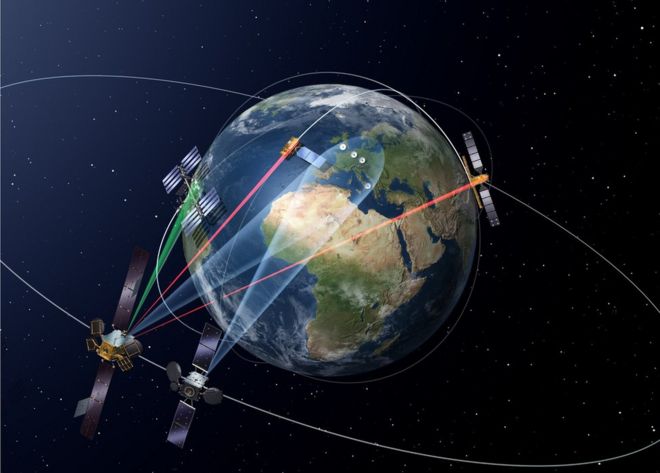
On Friday, the European Space Agency launched the first component of a network of satellites called the European Data Relay Satellite (EDRS). The 500 million euro project uses laser communication technology to improve the transfer of images between Earth and other satellites.
Currently images are sent using radio waves. Through this method, it can take hours for a satellite to send data back to Earth. The speed at which data can be transmitted is particularly critical when dealing with emergencies such as natural disasters or illegal activities out at sea. Lasers. on the other hand, can shorten the time it takes to convey information down to approximately 20 minutes. With this improvement, monitoring events like oil spills, floods, and glacial movement will be made much easier. The data transfer is estimated to be around 1.8Gbps. (The average Internet speed in the U.S. is about 12 Mbps.)
Laser communications technology will become more and more important as we attempt to venture farther from Earth. The difference between 20 minutes and a few hours is already significant, but keep in mind that Earth and the satellites it communicates with are between 700 km and 35,000 km apart. Compare this with the minimum possible distance between the Earth and Mars (54 million km) and you can already start to see why long distance communication by radio waves might pose an issue. With lasers, more information can be transferred and at a faster rate.
The EDRS is an intriguing project which offers many potential benefits regarding space travel and exploration. What are your thoughts on this project? Should the U.S. invest in this kind of technology? What other applications are associated with laser communication? To what degree will the EDRS improve activities here on Earth?
Sources:
http://www.telegraph.co.uk/news/science/space/12131158/Europe-launches-first-part-of-space-based-data-highway.html
http://www.bbc.com/news/science-environment-35446894
http://www.csmonitor.com/Technology/2016/0130/Why-lasers-are-better-for-communication-in-space
3 comments:
The EDRS project seems like it will be really useful for the US as well as for other countries. Even though it will probably be costly, I think that the US should invest in this kind of technology. The possible benefits that the US can take advantage of from the EDRS would make the expensive investment worth it in the long run.
Aside from space exploration and monitoring natural events on Earth, laser communications technology could also be used at airports to signal when an airplane has taken off or landed.
Laser communications technology seems really powerful and useful, but unfortunately it does have some limitations. According to Michael Rinn, the vice president of the Boeing Company Directed Energy Systems segment in Albuquerque, New Mexico, poor weather conditions such as heavy rain or sandstorms can hinder the effectiveness of lasers. But as the EDRS project continues, issues will most likely be addressed and taken care of.
Overall, I feel like the EDRS would make communications on Earth much more efficient. The US would definitely benefit from the improved speed at which information is transmitted and received.
sources:
http://www.militaryaerospace.com/articles/2012/06/laser-communications-feature.html
http://hyperphysics.phy-astr.gsu.edu/hbase/optmod/lasapp.html#c5
http://www.teach-ict.com/as_a2_ict_new/ocr/A2_G063/333_networks_coms/optical_wireless/miniweb/pg4.htm
I agree with Hannah. Even though this project will be costly, I believe that the United States will gain many things from it. As mentioned previously, it would help air traffic for flights and will also help when collecting data from the physical landscape; in addition, I believe that it would help significantly with defense. With this type of technology we would be able to detect faster whether nuclear testing explosions have gone off, and in a way “creep” on other countries activities (I know this is controversial but it is a possible application). Further, I believe that it would be able to better detect warming patterns in the ocean that help us predict natural phenomenon’s like El Nino and unnatural phenomenon’s like global warming.
I think that the project provides an excellent step forward in terms of communication technology. I think once other nations around the world see the success, they will end up following the same path, especially the US. Although, most of the US funding for the communication network would probably be from defense, looking at history. It would useful for the US because it might give an opportunity to kick start research into further space exploration considering that communication issues are lessened. It could also be useful for some car companies as better satellite data transfer speeds could help driverless cars in navigation.
Post a Comment